Related Research Articles
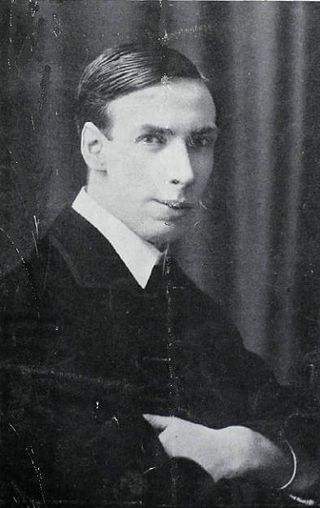
P. T. Selbit (1881–1938) was an English magician, inventor and writer who is credited with being the first person to perform the illusion of sawing a woman in half. Among magicians he was known for his inventiveness and entrepreneurial instinct and he is credited with creating a long list of successful stage illusions.

William Ellsworth Robinson was an American magician who went by the stage name Chung Ling Soo. He is mostly remembered today for his extensive use of yellowface in his act to falsely represent himself to be a Chinese man who spoke little English, as well as for his accidental death due to a failed bullet catch trick.

Harry Bouton Blackstone Jr. was an American stage magician, author, and television performer. He is estimated to have pulled 80,000 rabbits from his sleeves and hats.
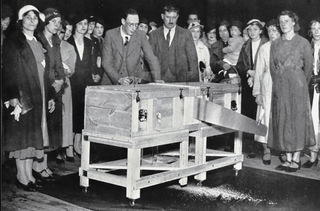
Sawing a woman in half is a generic name for a number of stage magic tricks in which a person is apparently cut or divided into two or more pieces.
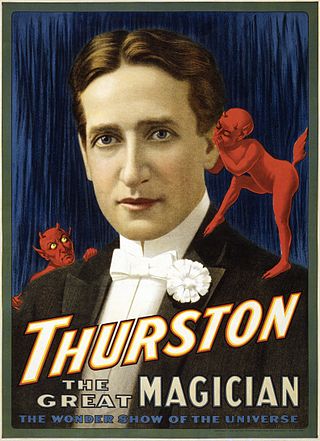
Howard Thurston was a stage magician from Columbus, Ohio, United States. As a child, he ran away to join the circus, where his future partner Harry Kellar also performed. Thurston was deeply impressed after he attended magician Alexander Herrmann's magic show and was determined to equal his work. He eventually became the most famous magician of his time. Thurston's traveling magic show was the biggest one of all; it was so large that it needed eight train cars to transport his road show.

The bullet catch is a stage magic illusion in which a magician appears to catch a bullet fired directly at them — often in the mouth, sometimes in the hand or sometimes caught with other items such as a dinner plate. The bullet catch may also be referred to as the bullet trick, defying the bullets or occasionally the gun trick.

John Henry Anderson (1814–1874) was a Scottish professional magician. Anderson is credited with helping bring the art of magic from street performances into theatres and presenting magic performances to entertain and delight the audience.

Alexander Herrmann was a French magician, better known as Herrmann the Great. He was married to magician Adelaide Herrmann, known as the Queen of Magic.
Tenko Hikita II, best known under the stage name of Princess Tenko and formerly Mari Asakaze, is a Japanese pop singer turned magician specialising in grand illusions.
The Zig-Zag Girl illusion is a stage illusion akin to the more famous sawing a woman in half illusion. In the Zig-Zag illusion, a magician divides an assistant into thirds, only to have them emerge from the illusion at the end of the performance completely unharmed.
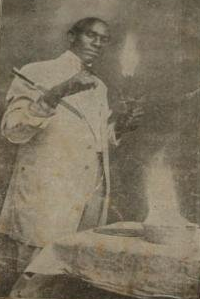
Benjamin Rucker was an American stage magician, better known by his stage name Black Herman. He was the most prominent African-American magician of his time.

A magician's assistant is a performer in a magic act who is not billed as the magician or principal name in the act.

Adelaide Herrmann (1853–1932) was an English magician and vaudeville performer billed as "the Queen of Magic." She was married to Alexander Herrmann, another magician.

Carl Hertz was an American magician.
Dell O'Dell was the stage name of Odella Newton an American magician regarded in her profession as a pioneer who provided a role model for modern female performers. She was noted for being one of the first magicians to appear on television, on her own show, The Dell O'Dell Show, on ABC's local station in Los Angeles in 1951. She was also one of few American women to have her own circus, the Della O'Dell Society Circus, which toured the Midwest in 1925 and 1926. Before becoming one of the most popular female magicians on the night club circuit during the 1930s, 40s, and 50s, Dell O'Dell also performed in vaudeville and burlesque. Her skills included juggling furniture and lecturing on physical culture.
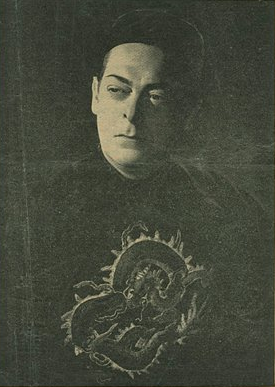
David Tobias "Theodore" Bamberg was an itinerant magician who traveled with his full evening magic show from the early to mid part of the 20th century. In Bamberg's autobiography, Robert Parrish wrote in the introduction that no other great illusionist could match Bamberg's skill. The Fu Manchu show was known for its comedy, drama, and color.

Shawn Farquhar is a Canadian magician and illusionist notable for his title as the "Grand Prix World Champion of Magic" from the International Federation of Magic Societies.

Magic, which encompasses the subgenres of illusion, stage magic, and close-up magic, among others, is a performing art in which audiences are entertained by tricks, effects, or illusions of seemingly impossible feats, using natural means. It is to be distinguished from paranormal magic which are effects claimed to be created through supernatural means. It is one of the oldest performing arts in the world.

Jonathan and Charlotte Pendragon were a husband-and-wife team of American illusionists who called their work "physical grand illusion". They are widely known due to numerous national and international television appearances.

A levitation illusion is one in which a magician appears to defy gravity by making an object or person float in the air. The subject may appear to levitate unassisted, or it may be performed with the aid of another object in which case it is termed a "suspension".
References
- 1 2 3 4 5 6 7 8 9 10 11 12 13 14 Sobanski, Julie (January 2008). "Ellen: Mistress of Modern Magic". M-U-M. Society of American Magicians. 97 (8): 52–54. ISSN 0047-5300.
- 1 2 3 "Armstrong Family Papers, 1900-1930 – Digital Collections". University of South Carolina Libraries. Retrieved 20 April 2021.
- 1 2 Charlton, Lauretta (2 April 2021). "Hanif Abdurraqib Celebrates Black Performance". The New York Times. Retrieved 20 April 2021.
- ↑ "The Importance of Black Magicians". The Magic Compass. The Society of American Magicians. 25 August 2015. Retrieved 20 April 2021.
- 1 2 Abdurraqib, Hanif (2021). A little devil in America : notes in praise of Black performance (First ed.). New York: Random House. pp. 62–65. ISBN 9781984801210.
- ↑ Haskins, James; Benson, Kathleen (2001). Conjure times : Black magicians in America. New York: Walker & Company. pp. 67–72. ISBN 9780802787620.